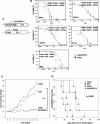Urokinase-type plasminogen activator receptor transcriptionally controlled adenoviruses eradicate pancreatic tumors and liver metastasis in mouse models
- PMID: 19484141
- PMCID: PMC2685441
- DOI: 10.1593/neo.81674
Urokinase-type plasminogen activator receptor transcriptionally controlled adenoviruses eradicate pancreatic tumors and liver metastasis in mouse models
Abstract
Treatment options for pancreatic cancer have shown limited success mainly owing to poor selectivity for pancreatic tumor tissue and to a lack of activity in the tumor. In this study, we describe the ability of the urokinase-type plasminogen activator receptor (uPAR) promoter to efficiently and selectively target pancreatic tumors and metastases, which enables the successful management of pancreatic cancer. We have generated a replication-defective reporter adenovirus, AduPARLuc, and a conditionally replicating adenovirus, AduPARE1A, and we have studied the selectivity and antitumoral efficacy in pancreatic tumors and metastases. Toxicity was studied on intravascular delivery. We demonstrate that the uPAR promoter is highly active in pancreatic tumors but very weak in normal tissues. Tumor specificity is evidenced by a 100-fold increase in the tumor-to-liver ratio and by selective targeting of liver metastases (P < .001). Importantly, the AduPARE1A maintains the oncolytic activity of the wild-type virus, with reduced toxicity, and exhibits significant antitumoral activity (25% tumor eradication) and prolonged survival in pancreatic xenograft models (P < .0001). Furthermore, upon intravascular delivery, we demonstrate complete eradication of liver metastasis in 33% of mice, improving median survival (P = 5.43 x 10(-5)). The antitumoral selective activity of AduPARE1A shows the potential of uPAR promoter-based therapies in pancreatic cancer treatment.
Figures






Similar articles
-
uPAR-controlled oncolytic adenoviruses eliminate cancer stem cells in human pancreatic tumors.Stem Cell Res. 2014 Jan;12(1):1-10. doi: 10.1016/j.scr.2013.09.008. Epub 2013 Sep 27. Stem Cell Res. 2014. PMID: 24141108
-
Intraductal delivery of adenoviruses targets pancreatic tumors in transgenic Ela-myc mice and orthotopic xenografts.Oncotarget. 2013 Jan;4(1):94-105. doi: 10.18632/oncotarget.795. Oncotarget. 2013. PMID: 23328228 Free PMC article.
-
AduPARE1A and gemcitabine combined treatment trigger synergistic antitumor effects in pancreatic cancer through NF-κB mediated uPAR activation.Mol Cancer. 2015 Jul 31;14:146. doi: 10.1186/s12943-015-0413-2. Mol Cancer. 2015. PMID: 26227809 Free PMC article.
-
Real-Time Fluorescence Image-Guided Oncolytic Virotherapy for Precise Cancer Treatment.Int J Mol Sci. 2021 Jan 17;22(2):879. doi: 10.3390/ijms22020879. Int J Mol Sci. 2021. PMID: 33477279 Free PMC article. Review.
-
Oncolytic adenovirus as pancreatic cancer-targeted therapy: Where do we go from here?Cancer Lett. 2023 Nov 28;579:216456. doi: 10.1016/j.canlet.2023.216456. Epub 2023 Nov 7. Cancer Lett. 2023. PMID: 37940067 Review.
Cited by
-
Oncolytic viral therapy for pancreatic cancer: current research and future directions.Oncolytic Virother. 2014 Feb 17;3:35-46. doi: 10.2147/OV.S53858. eCollection 2014. Oncolytic Virother. 2014. PMID: 27512661 Free PMC article. Review.
-
Oncolytic adenoviruses armed with thymidine kinase can be traced by PET imaging and show potent antitumoural effects by ganciclovir dosing.PLoS One. 2011;6(10):e26142. doi: 10.1371/journal.pone.0026142. Epub 2011 Oct 18. PLoS One. 2011. PMID: 22028820 Free PMC article.
-
The War on Cancer rages on.Neoplasia. 2009 Dec;11(12):1252-63. doi: 10.1593/neo.91866. Neoplasia. 2009. PMID: 20019833 Free PMC article.
-
Minimal RB-responsive E1A promoter modification to attain potency, selectivity, and transgene-arming capacity in oncolytic adenoviruses.Mol Ther. 2010 Nov;18(11):1960-71. doi: 10.1038/mt.2010.173. Epub 2010 Aug 31. Mol Ther. 2010. PMID: 20808288 Free PMC article.
-
Oncolytic virotherapy for pancreatic cancer.Expert Rev Mol Med. 2011 May 18;13:e18. doi: 10.1017/S1462399411001876. Expert Rev Mol Med. 2011. PMID: 21676289 Free PMC article. Review.
References
-
- Rustgi AK. The molecular pathogenesis of pancreatic cancer: clarifying a complex circuitry. Genes Dev. 2006;20:3043–3053. - PubMed
-
- Saif MW. Pancreatic cancer: are we moving forward yet? Highlights from the Gastrointestinal Cancers Symposium. Orlando, FL, USA. January 20th, 2007. JOP. 2007;8:166–176. - PubMed
-
- Alemany R. Cancer selective adenoviruses. Mol Aspects Med. 2007;28:42–58. - PubMed
-
- Nemunaitis J, Senzer N, Sarmiento S, Zhang YA, Arzaga R, Sands B, Maples P, Tong AW. A phase I trial of intravenous infusion of ONYX-015 and enbrel in solid tumor patients. Cancer Gene Ther. 2007;14:885–893. - PubMed
-
- Hecht JR, Bedford R, Abbruzzese JL, Lahoti S, Reid TR, Soetikno RM, Kirn DH, Freeman SM. A phase I/II trial of intratumoral endoscopic ultrasound injection of ONYX-015 with intravenous gemcitabine in unresectable pancreatic carcinoma. Clin Cancer Res. 2003;9:555–561. - PubMed
Publication types
MeSH terms
Substances
Grants and funding
LinkOut - more resources
Full Text Sources
Other Literature Sources
Medical
